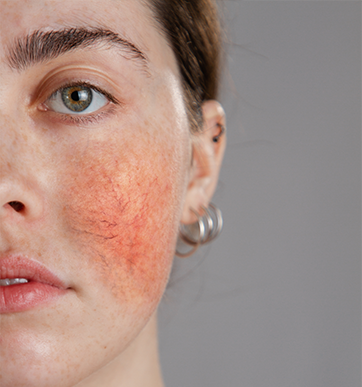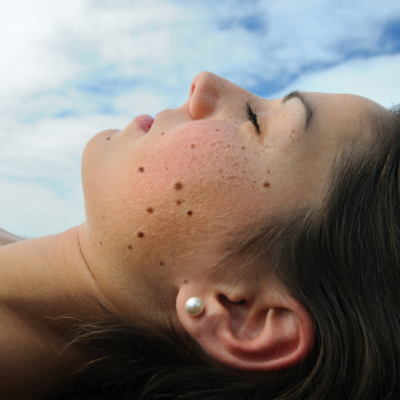
Dealing with Rosacea
Reviewed by Azita Simoni, MD
Over the years, California Skin Institute practitioners have helped many patients suffering from rosacea. With millions of Americans affected by this condition, it’s surprising that rosacea doesn’t get more media coverage. Perhaps one of the reasons is because this skin condition is very much misunderstood and is often even confused for other problems, like eczema or acne. Unfortunately, because many sufferers often don’t realize that this condition is quite manageable with the right rosacea treatments, they delay seeking help until the symptoms become severe and lead to changes in skin texture or even the shape of the nose.
Rosacea Symptoms
Rosacea can be divided into two sub types: papulopustular and erythrotelangiectatic. The former typically presents with red bumps on the skin that can resemble acne, while the latter is associated with more general redness and prolonged flushing of the face. However, there are many symptoms associated with rosacea, and a patient can present with many combinations of these.
- Redness and Swelling: For many patients, this skin condition is marked by prolonged redness and swelling, which can also be accompanied by an itching or burning sensation. Flushing of the face, especially the cheeks, is also quite common.
- Bumps: With papulopustular rosacea, the patient develops bumps on the skin that resemble acne. Here at California Skin Institute, we’ve had numerous patients who visited us because they thought they were dealing with adult acne and were frustrated because over-the-counter acne medication wasn’t effective. But upon closer examination, the issue turned out to be rosacea – and we were able to help them get their symptoms under control with proper treatment.
- Nose Shape: One of the more severe symptoms is the development of a bulbous appearance of the nose. It’s a very aggravating symptom because it can drastically change the patient’s appearance and affect their self esteem. It can be difficult to cope with psychologically – even the famous banking magnate JP Morgan who was one of the richest men in the world, suffered from a dramatic change in the appearance of his nose due to rosacea, and is said to have been very self-conscious about it
- Eye Problems: Perhaps some of the most uncomfortable rosacea symptoms occur when the condition affects the eyes. In such cases the eyes appear bloodshot and have a painful, stinging sensation.
It is important to keep in mind that symptoms can occur in varying combinations and with different severities. This makes it imperative to develop a custom-tailored treatment plan that addresses your unique needs, to provide long term relief.
What Causes Rosacea
In order to understand how to treat rosacea, we have to consider what causes the problem in the first place. Although science doesn’t fully understand this skin condition, patients who present with symptoms tend to be between 30 and 50 years of age, and usually have light skin (of course, individuals outside of this age range can also develop rosacea).
- Blood Vessels: One of the causes of rosacea is thought to be the excessive dilation of blood vessels that are near the surface of the skin. This is what creates that characteristic redness associated with this skin condition.
- Bacteria: Another facilitator of the problem is thought to be harmless bacteria that elicit an inflammatory response from the body.
- Genetics: Hereditary factors are also thought to play a role, as many rosacea patients report having family members who struggled with this condition as well.
- Life Events: Additionally, rosacea often seems to be triggered by certain life events and daily habits. With some individuals, stress seems to be a triggering factor. Prolonged exposure to the sun and extreme weather conditions (very hot or cold climates) is also thought to be a trigger.
- Habits: More routine triggers of rosacea may also come in the form of excessive exercise (where the face becomes very flushed), hot showers or baths, consumption of alcohol and spicy foods – all are believed to have a triggering effect on rosacea relapses.
- Skin Products: Skin care products that cause irritation are also thought to be a trigger.
Rosacea Treatments
Before discussing specific treatment options, it’s important to note that actively treating rosacea is a vital aspect of keeping this condition under control. The problem with avoiding treatment is that rosacea symptoms can become more severe over time unless the condition is kept in check. Although this skin issue cannot yet be cured, a proactive management system can go a long way in reducing visual symptoms and reducing future relapses.
When you visit California Skin Institute for your rosacea consultation, your board-certified dermatologist or advanced practitioner will develop a customized treatment plan. Here are just some of the steps that may be involved in your treatment:
- Medicated Creams: There are specific prescription creams that, through various mechanisms of action, are effective at managing rosacea. Steroid creams are generally not used for rosacea, as they can actually exacerbate the condition in the long term.
- Skin Lasers: To address rosacea-induced redness, your California Skin Institute physician may suggest laser skin treatments to target some of the small blood vessels near the surface of the skin (for example, the Excel V laser is one such device). After even one treatment, small surface blood vessels are damaged and the redness in the face can be significantly reduced.
- Trigger Control: As part of your consultation, your California Skin Institute licensed practitioner will carefully review the possible trigger factors in your life that may be exacerbating symptoms. Through a careful analysis, you may begin to see trigger patterns. By controlling these events, patients may further reduce symptoms of this condition.
- Skin Care Routine: To further help you reduce recurrences of rosacea, board-certified experts can help you assess the skin products you are using, to identify potential irritants that may be contributing to your symptoms.
- Surgery: For patients with serious symptoms, like changes in the shape of the nose, our experienced surgeons can target the excess tissue and return the nose to its natural shape.
Again, it cannot be overstated how important it is to devise a customized treatment plan that addresses your specific symptoms and skin attributes. Through an individualized approach, our physicians can create a plan that can minimize your symptoms and help you get rosacea under control.
Your Rosacea Consultation
If you’d like to speak to one of our experienced, compassionate practitioners about treating rosacea, schedule an appointment today.



 / 291 Reviews
/ 291 Reviews